
While the economic downturn has seeped into every sector of the economy, there is a more optimistic story being told by small businesses across America. Despite the bad news, Inc. magazine’s recent list of America’s fastest-growing companies celebrated 500 businesses that are adding jobs to their payrolls and profits to their bottom lines.
Since 2010, the elite 500 raked in $366 billion in revenue and created 370,592 jobs. With an average of 51 employees, these vibrant companies achieved an average of $10 million in revenue and a growth rate of 94 percent. More surprising still, many of these small business hotbeds originate from previously troubled industries like real estate, telecommunications, financial services and insurance.
If Inc.’s past fast-growing honorees like Microsoft, Oracle and Zappos are any measure; small business start-ups redefine the American economy and create most of the nation’s new jobs. This potential for innovation bodes well for Atlanta, which ranked seventh on Inc.’s list of job-creating cities, just behind powerhouses like New York, Los Angeles and Chicago.
In addition to being home to Fortune 1000 favorites like Home Depot, Russell Athletic and Lockheed Martin, Cobb County is the launching pad for seven of the fast-growing start-ups that made Inc.’s list, including Valuation Management Group, Property Masters, PalmerHouse Properties, Maximum One Realty, Flip Flop Shops, Axis Teknologies and LogFire.
To discuss Cobb County’s home field advantage when it comes to small business growth, Cobb In Focus spoke with a few award-winning small businesses about their path to greatness and what it takes to grow and build an organization that can weather the storms of economic adversity.
PalmerHouse Properties
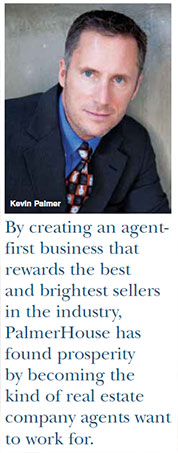 One day, while sitting in his kitchen and pondering nothing in particular, Kevin Palmer had an entrepreneurial epiphany. As a 20-year veteran of the financial services industry, Palmer decided he wanted to start a real estate company.
One day, while sitting in his kitchen and pondering nothing in particular, Kevin Palmer had an entrepreneurial epiphany. As a 20-year veteran of the financial services industry, Palmer decided he wanted to start a real estate company.
The year was 2006—just before the dawn of the real estate crisis that left a path of foreclosures and short sales in its wake. Despite the odds, Palmer was prepared for the worst. “Since I came from a financial services background, I saw what was about to happen in 2006,” says Palmer, CEO and founder of PalmerHouse Properties. “If you start a business from zero, there’s really nowhere you can go but up, and since then we’ve doubled in size in terms of our agent count and revenue year over year.”
With the help of a unique business model, PalmerHouse was able to weather the rough real estate market. “We really saw the opportunity to do something different by focusing on our clients,” says Palmer. “We consider our clients to be real estate agents and their clients are the buyers and sellers.” While agents at most real estate companies are lucky to take home 50 to 80 percent of their commissions, PalmerHouse agents take home everything. “We operate on a transactional model platform,” explains Palmer, “which means agents get to keep 100 percent of their commission in exchange for a small monthly fee to affiliate with us.”
By creating an agent-first business that rewards the best and brightest sellers in the industry, PalmerHouse has found prosperity by becoming the kind of real estate company agents want to work for. Affiliated agents set their own priorities and sales goals, specialize in the properties of their choice and have the ability to set their own commission rates, which allows them to be more competitive when it comes to wooing cost conscious buyers and sellers.
Since its inception in 2006, PalmerHouse Properties has grown from a small business to a sizable privately held corporation employing 625 to 650 agents. Though the company got its start in Buckhead and Atlanta, it recently opened a Cobb County branch in Marietta. “We started seeing more and more Cobb County agents who were driving in to our Buckhead office,” says Palmer. “Once we got to 30 agents we decided it was time to make a move to support our Cobb team, which now includes 78 agents. The county government has been very supportive and wonderful to work with, and home values have been much more stable in Cobb County. The agent base is strong, and the client base is very well educated and career oriented. It’s been exciting to see our company grow in Cobb and to watch our agents become more and more prosperous.”
With close to $4 million in gross revenue in 2011 alone, it’s no surprise that PalmerHouse Properties was recently named to Inc. magazine’s list of the 500 fastest-growing businesses in America. “It was so exciting, and it really came as a surprise to us,” says Palmer. “We were thrilled, and it’s been such a great marketing opportunity.”
Faced with a future that includes the potential for exponential growth, the company recently completed its next phase of expansion with the opening of a Gwinnett office in January. “In 2012, we have a goal to exceed revenues of $8 million and reach 1,500 agents,” says Palmer, with a hint of excitement in his voice. Along with an agent-friendly, high-end, high-touch image, Palmer says his namesake business “is built on an attitude of respecting people, having fun and making money. It sounds strange,” he says, “but we never focused on the money aspect all that much. If you focus on service and do what’s right 100 percent of the time, the money always follows.”
Puckett EMS
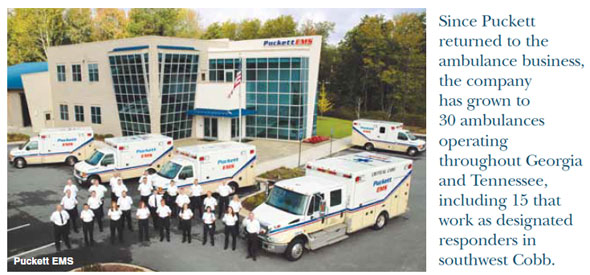
Steve Puckett began his fledgling emergency transport business with one vehicle in 1983, often working 24-hour shifts at a time. After selling his business during a nationwide ambulance consolidation effort in the 1990s, Puckett began hearing complaints about lagging emergency response times. “In 2001, Steve saw a need in the community and decided it was time to go back into the ambulance business,” says Shane Garrison, vice president of Puckett EMS.
Since Puckett returned to the ambulance business, the company has grown to 30 ambulances operating throughout Georgia and Tennessee, including 15 that work as designated responders in southwest Cobb. “Since 2001 there’s been nothing but steady, controlled population growth,” says Garrison. “We’ve experienced a 25 percent increase in call volume and non-emergency transport volume from moving patients to different hospitals within the WellStar Health System. We’ve also built a very good reputation and are one of only four accredited ambulance services in the state of Georgia, and one of 130 in the U.S.” The company’s sterling reputation resulted in a recent expansion into Tennessee, where Puckett EMS serves as the official transport service for Erlanger Hospitals.
Though the growth of the business has been strong, Garrison says the tough economy has left its mark. “We’ve had to increase the amount of indigent care we provide,” Garrison says. “We are definitely not insulated—as people lose their jobs and lose their insurance, they lose the ability to pay for our services, but we won’t compromise on patient care.” To rein in expenses, Puckett EMS is looking to transition to more fuel-efficient vehicles. “The maintenance costs are a lot less and fuel costs dramatically improve,” says Garrison.
Much of Puckett’s success comes from their location. “Quality of life for employees is very important, and great schools are just one of the reasons why Cobb is a great place to do business,” says Garrison, a life-long Cobb resident. “Ninety percent of our workforce lives in the county, and it’s important that we have several schools in the area that train paramedics and emergency technicians. Some counties have a shortage of EMTs and paramedics because they don’t have access to teaching and certification institutions.”
As Puckett EMS plans for the uncertain future of health care, Garrison sees the company expanding by leaps and bounds. “Hospitals will continue to experience explosive growth, and we will grow right along with them,” he says. “The face of health care will change dramatically in the coming years, and I believe Puckett EMS will offer more than just emergency transport. We will be bringing preventive health care to patients rather than having them go to hospitals to incur more expensive health care.”
Regardless of how Puckett EMS expands in the future, the company’s continued presence in Cobb County is certain. “Cobb has a little bit of everything,” says Garrison. “There are no ivory towers—Cobb County is all about family. I’m proud to be a Cobb County citizen, and I appreciate the support everyone in the county gives us.”
K-9 Coach
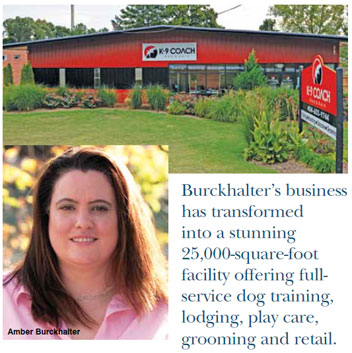 While studying to become an attorney, Amber Burckhalter suffered a health crisis that brought her dream to a sudden end. “I didn’t know what to do with my life, so I went back to what I knew,” says Burckhalter, who founded K-9 Coach 13 years ago. “I had worked at a vet center, and I always loved animals.”
While studying to become an attorney, Amber Burckhalter suffered a health crisis that brought her dream to a sudden end. “I didn’t know what to do with my life, so I went back to what I knew,” says Burckhalter, who founded K-9 Coach 13 years ago. “I had worked at a vet center, and I always loved animals.”
After working with national trainers, Burckhalter began providing in-home dog training to clients with unruly canines, eventually expanding her business to an animal hospital parking lot. Ten years later, Burckhalter’s business has transformed into a stunning 25,000-square-foot facility offering full-service dog training, lodging, play care, grooming and retail.
The idea for her Bed and Bark facility came from clients who complained that their dogs were learning bad habits at other boarding facilities. Burckhalter listened to her clients and built a facility that employs 27 people and brings in over $1 million in annual revenue from 1,900 loyal clients. “The median income is supportive of small businesses like mine,” says Burckhalter, “and Cobb County really seems to understand that new businesses bring jobs.”
While she has thrived over the past decade, Burckhalter admits that her business has had to respond to the challenging economic times. “People try to take care of their animals as best as they can, so we’ve started to offer different economic packages and tiers of training—from $60 to $3,000—to try to reach everyone and every economic bracket,” says Burckhalter. “We also offer a wider variety of toys and treats to meet all budgets, as well as a frequent flyer program that includes a boarding rate reduction of 30 percent.”
When Burckhalter isn’t at her office surrounded with pets and people, she is taking her young son to soccer and karate and spending time with her family, which includes an 18-year-old cat, a Sheba Inu and a French bulldog. “You have to figure out what you’re good at and passionate about, and you have to love what you’re doing,” she says. “I started this business out of necessity—it was not the route I had planned, but it was the route I was supposed to take, and it has been a huge blessing in my life.”
Sellier Design
 After working as an in-house graphic designer for IBM and leading design firms where her clients included Kodak, Macy’s and The New York Times, Kriston Sellier opened her own graphic and web design company in 2001 and “hasn’t looked back since.” In 2004, Sellier moved her at-home design business to Marietta so her husband could be closer to his job at CarMax’s Kennesaw branch.
After working as an in-house graphic designer for IBM and leading design firms where her clients included Kodak, Macy’s and The New York Times, Kriston Sellier opened her own graphic and web design company in 2001 and “hasn’t looked back since.” In 2004, Sellier moved her at-home design business to Marietta so her husband could be closer to his job at CarMax’s Kennesaw branch.
“I love living in Cobb County because of the great schools,” says Sellier. “There are so many lifestyle options, from townhomes and horse farms, and lots of recreation areas where my kids can play sports. I love how close I am to parks and recreation facilities—Lost Mountain is really one of our favorite places to be.”
Voted a Top 25 Best Small Company by Working Mother magazine and a 2009 winner of the Small Business Commerce Association’s Best of Business Award, Sellier Design has three full-time employees and has garnered numerous design awards, including several American Corporate Identity Awards.
Although the economic downturn has made doing business in any field more difficult, Sellier says her company has weathered the recession thanks to discovering the value of networking. “We’re doing well, and I would attribute that to networking—getting new business clients through referrals and maintaining good relationships with the ones we already have,” she says. “I’d never really done networking before, but right before the recession hit we recruited 25 new clients through networking, which helped us tremendously. You can make so many great connections in the community, and it is a lot less of an investment than you might think.”
That networking has certainly paid off, as Sellier Design now currently manages the account of Freshens, the second largest restaurant franchise in Georgia. Sellier Design takes a holistic approach to brand management by offering clients website analysis and design, advertising resources, stationery and marketing collateral, corporate identity, logo design and search engine optimization. The company’s list of past and present clients includes The Silver Platter, Zoo Atlanta, Russell Athletic Corporation, Novient, Cox Communications, Atlantic Realty Partners and the American Hiking Society. “A lot of design firms set up shop in edgy urban areas known for art, but I wanted to be near my family,” says Sellier, “and I’ve found that being in a place like Cobb County has afforded us access to many small business clients who aren’t served by downtown firms.”
Although she has big plans for the future, Sellier’s business won’t end up on Inc.’s fastest-growing list anytime soon. “I see Sellier Design maintaining the quantity of employees and clients we have, and not growing by leaps and bounds because I want to maintain a good work-life balance and continue creating award-winning work that helps clients take their businesses to the next level,” she says. “Innovation is what small businesses in America are all about—the freedom to determine what they want to do and who they want to become.”












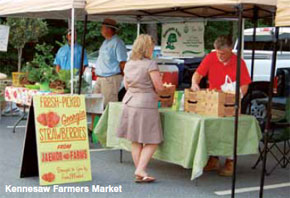 The variety of produce at most local farmers markets makes it easier to vary the fruits and vegetables in your diet. “You find many varieties you won’t find in your big chain grocery stores,” says Johnny Fulmer, founder of the Marietta Square Farmers Market. Just as important, he adds, farmers markets offer fruits and vegetables pulled fresh from the earth. “We encourage our vendors to leave the vegetables in their natural state,” Fulmer says. “For instance, our garlic grower puts his garlic on the table fresh from the ground. It has dirt on it. This guy grew it, he knows what it tastes like and, if you ask him, he will tell you how to use every bit of it. You can’t get that at the grocery store.”
The variety of produce at most local farmers markets makes it easier to vary the fruits and vegetables in your diet. “You find many varieties you won’t find in your big chain grocery stores,” says Johnny Fulmer, founder of the Marietta Square Farmers Market. Just as important, he adds, farmers markets offer fruits and vegetables pulled fresh from the earth. “We encourage our vendors to leave the vegetables in their natural state,” Fulmer says. “For instance, our garlic grower puts his garlic on the table fresh from the ground. It has dirt on it. This guy grew it, he knows what it tastes like and, if you ask him, he will tell you how to use every bit of it. You can’t get that at the grocery store.”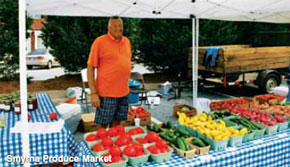 Welch says that given the obesity epidemic in Georgia and across the nation, exposing children to fresh and local food is absolutely critical. “This is the first generation that may not outlive their par-ents,” she says. A weekly trip to the farmers market is a fun way for families to create lifelong healthy habits. Kirk is equally passionate about making fresh and local a part of children’s daily lives. “I grew up on my grandfather’s farm, and in the summertime we ate from our garden every day,” she recalls. “Every child and every family should experience that.”
Welch says that given the obesity epidemic in Georgia and across the nation, exposing children to fresh and local food is absolutely critical. “This is the first generation that may not outlive their par-ents,” she says. A weekly trip to the farmers market is a fun way for families to create lifelong healthy habits. Kirk is equally passionate about making fresh and local a part of children’s daily lives. “I grew up on my grandfather’s farm, and in the summertime we ate from our garden every day,” she recalls. “Every child and every family should experience that.”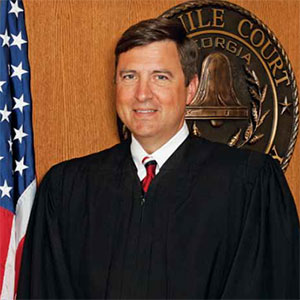
 The Story: I was born and raised in Marietta. It’s the only place I’ve ever lived, other than when I went away to school. I got my undergraduate degree from Presbyterian College and my Juris Doctor degree from Cumberland School of Law at Samford University. After law school, I practiced with Hylton Dupree in Marietta for 18 years. I live with my wife, Lucia, who teaches advanced math at Harrison High School.
The Story: I was born and raised in Marietta. It’s the only place I’ve ever lived, other than when I went away to school. I got my undergraduate degree from Presbyterian College and my Juris Doctor degree from Cumberland School of Law at Samford University. After law school, I practiced with Hylton Dupree in Marietta for 18 years. I live with my wife, Lucia, who teaches advanced math at Harrison High School.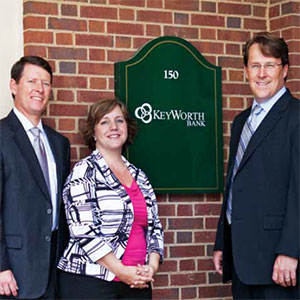
 KeyWorth Bank entered the North Fulton and Gwinnett area market in 2007 with a team of seasoned commercial bankers
KeyWorth Bank entered the North Fulton and Gwinnett area market in 2007 with a team of seasoned commercial bankers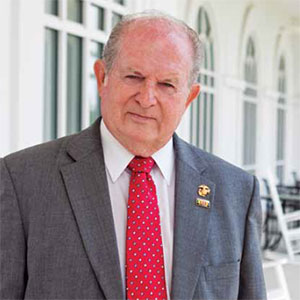
 Bill Byrne served as Chairman of the Cobb County Board of Commissioners from 1992 until 2002. He is a veteran of the U.S. Marine Corps and since 1972 has owned the Byrne Design Group, a planning firm that focuses on master planning, site planning, environmental impact analysis and zoning presentations.
Bill Byrne served as Chairman of the Cobb County Board of Commissioners from 1992 until 2002. He is a veteran of the U.S. Marine Corps and since 1972 has owned the Byrne Design Group, a planning firm that focuses on master planning, site planning, environmental impact analysis and zoning presentations.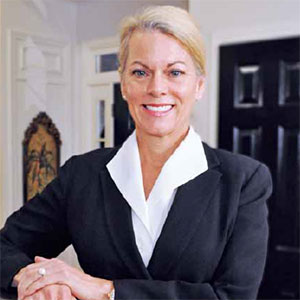
 The Story: I was born in Kinston, N.C., but grew up in Knoxville, Tenn., then moved to Atlanta in 1986. I earned my bachelor’s from Trinity University and my Juris Doctorate from Atlanta’s John Marshall Law School. After I passed the bar, I worked as an associate for a law firm that focused on personal injury and criminal defense, then I was hired as a prosecutor for the Cobb County Solicitor’s Office. Two years later, I was offered a position at the Cobb County District Attorney’s office as an Assistant District Attorney prosecuting Crimes Against Children. In 2000, I opened my own law firm. I am involved with many community organizations, like the Chamber of Commerce, Kiwanis Club and East Cobb Business Association, among others. I am a candidate for Cobb County State Court Judge, Division II, Post 2, in the primary election on July 31, 2012, and I have been endorsed by law enforcement and we would appreciate your support and vote.
The Story: I was born in Kinston, N.C., but grew up in Knoxville, Tenn., then moved to Atlanta in 1986. I earned my bachelor’s from Trinity University and my Juris Doctorate from Atlanta’s John Marshall Law School. After I passed the bar, I worked as an associate for a law firm that focused on personal injury and criminal defense, then I was hired as a prosecutor for the Cobb County Solicitor’s Office. Two years later, I was offered a position at the Cobb County District Attorney’s office as an Assistant District Attorney prosecuting Crimes Against Children. In 2000, I opened my own law firm. I am involved with many community organizations, like the Chamber of Commerce, Kiwanis Club and East Cobb Business Association, among others. I am a candidate for Cobb County State Court Judge, Division II, Post 2, in the primary election on July 31, 2012, and I have been endorsed by law enforcement and we would appreciate your support and vote.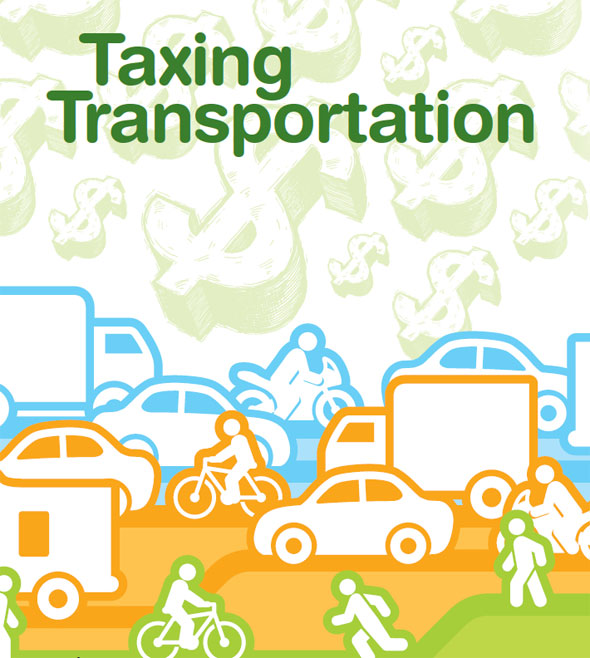

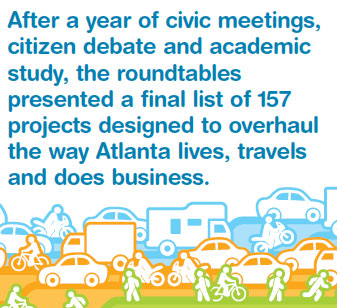 After a year of civic meetings, citizen debate and academic study, the roundtables presented a final list of 157 projects designed to overhaul the way Atlanta lives, travels and does business. “Our economy works best when goods and people can get to where they need to go efficiently,” says Lawler, “and investing in infrastructure means employers suddenly have a larger talent pool to choose from, and employees have a greater number of jobs to choose from.”
After a year of civic meetings, citizen debate and academic study, the roundtables presented a final list of 157 projects designed to overhaul the way Atlanta lives, travels and does business. “Our economy works best when goods and people can get to where they need to go efficiently,” says Lawler, “and investing in infrastructure means employers suddenly have a larger talent pool to choose from, and employees have a greater number of jobs to choose from.”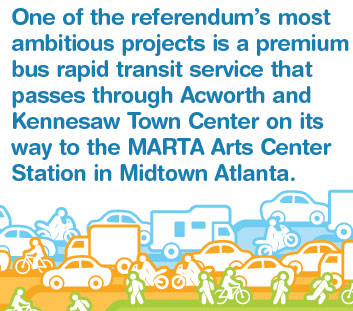 One of the referendum’s most ambitious projects is a premium bus rapid transit service that passes through Acworth and Kennesaw Town Center on its way to the MARTA Arts Center Station in Midtown Atlanta. “The project will include dual, reversible lanes independent of other traffic,” says Lee of the $700 million project. “The lanes will only carry commuter buses and bypass 75 entirely.” In the future, the bus line could be augmented with a light rail line for Cobb commuters traveling to Atlanta. “The Northwest Corridor transit project would provide great benefits for seniors and young residents of rapidly growing activity centers like Kennesaw, Marietta and Cumberland,” says Faye DiMassimo, director of the Cobb County Department of Transportation and a supporter of the referendum. “We’re currently working with several companies who are thinking about relocating to the region, but they’re sitting on the sidelines right now because of the congestion,” says Bass, who is keenly aware of the bill’s impact on economic development. In addition to maintaining a corporate edge, the region is expected to gain 34,000 construction jobs and 200,000 permanent jobs, most in the medium- to high-paying sectors, as a result of the planned projects.
One of the referendum’s most ambitious projects is a premium bus rapid transit service that passes through Acworth and Kennesaw Town Center on its way to the MARTA Arts Center Station in Midtown Atlanta. “The project will include dual, reversible lanes independent of other traffic,” says Lee of the $700 million project. “The lanes will only carry commuter buses and bypass 75 entirely.” In the future, the bus line could be augmented with a light rail line for Cobb commuters traveling to Atlanta. “The Northwest Corridor transit project would provide great benefits for seniors and young residents of rapidly growing activity centers like Kennesaw, Marietta and Cumberland,” says Faye DiMassimo, director of the Cobb County Department of Transportation and a supporter of the referendum. “We’re currently working with several companies who are thinking about relocating to the region, but they’re sitting on the sidelines right now because of the congestion,” says Bass, who is keenly aware of the bill’s impact on economic development. In addition to maintaining a corporate edge, the region is expected to gain 34,000 construction jobs and 200,000 permanent jobs, most in the medium- to high-paying sectors, as a result of the planned projects.

 One day, while sitting in his kitchen and pondering nothing in particular, Kevin Palmer had an entrepreneurial epiphany. As a 20-year veteran of the financial services industry, Palmer decided he wanted to start a real estate company.
One day, while sitting in his kitchen and pondering nothing in particular, Kevin Palmer had an entrepreneurial epiphany. As a 20-year veteran of the financial services industry, Palmer decided he wanted to start a real estate company.
 While studying to become an attorney, Amber Burckhalter suffered a health crisis that brought her dream to a sudden end. “I didn’t know what to do with my life, so I went back to what I knew,” says Burckhalter, who founded K-9 Coach 13 years ago. “I had worked at a vet center, and I always loved animals.”
While studying to become an attorney, Amber Burckhalter suffered a health crisis that brought her dream to a sudden end. “I didn’t know what to do with my life, so I went back to what I knew,” says Burckhalter, who founded K-9 Coach 13 years ago. “I had worked at a vet center, and I always loved animals.” After working as an in-house graphic designer for IBM and leading design firms where her clients included Kodak, Macy’s and The New York Times, Kriston Sellier opened her own graphic and web design company in 2001 and “hasn’t looked back since.” In 2004, Sellier moved her at-home design business to Marietta so her husband could be closer to his job at CarMax’s Kennesaw branch.
After working as an in-house graphic designer for IBM and leading design firms where her clients included Kodak, Macy’s and The New York Times, Kriston Sellier opened her own graphic and web design company in 2001 and “hasn’t looked back since.” In 2004, Sellier moved her at-home design business to Marietta so her husband could be closer to his job at CarMax’s Kennesaw branch.
